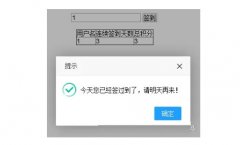PHP实现的简单缓存类
时间:2023-12-12下面是PHP实现的简单缓存类的完整攻略。
什么是缓存?
缓存是一种提高应用性能和可扩展性的方式,它将计算结果或者设备响应存储在内存或磁盘中,然后重复使用,这样就避免了相同的计算或响应。缓存通常用于频繁读取数据或计算的场景,例如数据库查询或者API请求等。
为什么需要缓存?
相较于网络存储的读写速度,内存和磁盘存储读写速度快得多,需要读写的数据越大,这种差距也就越大,缓存就是一种牺牲一些存储空间的方式来换取运行速度的提高。
如何实现简单的缓存类?
实现一个简单的缓存类需要有以下几个基本步骤:
- 配置缓存的存储方式
- 根据业务需要设计缓存键值对
- 编写缓存读写操作
- 利用缓存提高应用性能
下面是一个PHP实现的简单缓存类。
<?php
class SimpleCache
{
private $_cache_path = '';
private $_cache_expire = 60;
public function __construct()
{
$this->_cache_path = dirname(__FILE__) . '/cache/';
}
public function get($key)
{
$cache_path = $this->_cache_path . md5($key);
if (!@file_exists($cache_path)) {
return false;
}
if (time() - @filemtime($cache_path) > $this->_cache_expire) {
@unlink($cache_path);
return false;
}
$data = file_get_contents($cache_path);
return unserialize($data);
}
public function set($key, $data, $expire = 60)
{
$cache_path = $this->_cache_path . md5($key);
$data = serialize($data);
file_put_contents($cache_path, $data);
}
public function clear()
{
$files = glob($this->_cache_path . '*');
foreach ($files as $file) {
if (is_file($file)) {
@unlink($file);
}
}
}
}
上述代码实现了一个简单的缓存类SimpleCache,其中
_cache_path为缓存文件的存放路径,默认为./cache/;_cache_expire为缓存数据的失效时间,默认为60秒;
该缓存类包含了三个常用的方法:
get($key):获取指定缓存键的缓存数据,如果缓存不存在或已经过期,则返回false;set($key, $data, $expire = 60):将指定的数据存入指定的缓存键,并设置过期时间;clear():清除所有缓存数据。
示例说明
接下来,我们分别展示两个示例说明,具体实现可参考下述代码:
示例一:使用缓存提高API请求性能
下面是一个使用简单缓存类提高API请求性能的示例。
<?php
// 引入SimpleCache类
require_once 'SimpleCache.php';
$cache = new SimpleCache();
// 定义API的URL和参数
$url = 'https://api.exmaple.com/data';
$params = array('key' => 'xxxx', 'id' => '1234');
// 构造请求URL
$url_with_params = $url . '?' . http_build_query($params);
// 尝试从缓存中获取数据
$data = $cache->get($url_with_params);
if ($data === false) {
// 缓存中没有该数据,请求API并将数据缓存到缓存类中
$data = file_get_contents($url_with_params);
$cache->set($url_with_params, $data, 3600); // 数据在缓存中生命周期为1小时
}
// 处理API返回的数据 ...
该示例中,我们首先定义了API的URL和参数,根据这些参数构造了请求URL,然后我们尝试从缓存类中获取请求URL对应的API数据,如果该URL在缓存中存在,则立即返回缓存的数据。如果不存在,则向API发送请求,获取数据,并将数据缓存到缓存类中,下次调用该API时就可以直接使用缓存。
示例二:缓存静态页面提高性能
下面是一个使用简单缓存类缓存静态页面的示例。
<?php
// 引入SimpleCache类
require_once 'SimpleCache.php';
$cache = new SimpleCache();
// 定义要缓存的页面URL
$url = 'http://www.example.com/';
// 尝试从缓存中获取页面内容
$html = $cache->get($url);
if ($html === false) {
// 缓存中没有该页面数据,请求页面并将页面内容缓存到缓存类中
$html = file_get_contents($url);
$cache->set($url, $html, 3600); // 页面在缓存中生命周期为1小时
echo $html; // 第一次生成页面,输出页面内容
} else {
// 缓存中有该页面数据,直接输出缓存内容
echo $html; // 从缓存中读取,输出页面内容
}
该示例中,我们定义了要缓存的页面URL,尝试从缓存中获取页面内容,如果缓存中没有该数据,则向页面URL发送请求,获取页面内容,并将数据缓存到缓存类中,下次访问该页面时则可以直接从缓存中读取数据,并输出缓存内容。
 PHP+ajax+mysql+layui实现每日签到及提醒功能这篇文章主要为大家详细介绍了使用 PHP + layui 实现每日 签到 及提醒功能,具有一定的参考价值,感兴趣的小伙伴们可以参考一下,首次签到获得1个积分,第二次签到获得2个积
PHP+ajax+mysql+layui实现每日签到及提醒功能这篇文章主要为大家详细介绍了使用 PHP + layui 实现每日 签到 及提醒功能,具有一定的参考价值,感兴趣的小伙伴们可以参考一下,首次签到获得1个积分,第二次签到获得2个积